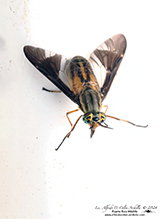adulterous deer fly
(Chrysops moechus)
Conservation • Description • Habitat • Ecology • Distribution • Taxonomy
|
|
||||||||||||||
Description |
Adulterous deer fly is a common, relatively small, deer fly. It occurs in the United States and southern Canada east of the Great Plains. Adulterous deer fly larvae are aquatic and predaceous, feeding on other insect larvae and on worms. Adults are active from June through August in Minnesota. They are found in open woodlands and wetlands, often near the margins of streams and ponds.Males feed on plant nectar. Females feed on the blood of mammals. Males are 5⁄16″ to ⅜″ (8.2 to 9 mm) in length. They are relatively rare, and they are difficult to identify to the species level. Female adults are ¼″ to 5⁄16″ (7.1 to 8.4 mm) in length. The body is stout and brownish yellow with dark markings. The wings have dark markings. The head is broad, and it is covered with light yellow hairs. The compound eyes are bulging, iridescent, and brightly colored. On males they meet at the top of the head. On females they do not meet. There are three simple eyes (ocelli). The area around the ocelli (ocellus spot) is brown with three black spots and an ocellus in the center of each spot. Females have a large, bare, hardened area (frontal callus) on the front of the head between the compound eyes. The frontal callus is entirely brownish black and not very shiny. The antennae have three segments. The first segment (scape) and second segment (pedicel) are reddish yellow and are densely covered with fine black hairs. The third segment (flagellum) is long, clearly ringed, and black. The large, bare, hardened area on the face (facial callus) is reddish yellow. The small, bare, hardened areas on each cheek (cheek callus) is brownish black or black. The mouthparts are modified for piercing flesh. The finger-like sensory mouthparts (palps) are reddish yellow. The upper side of the thorax is bluish green with a narrow brown longitudinal stripe in the middle and a broader stripe on each side. On each side of the thorax there is a brown stripe between the base of the wing and the shoulder (humeral) angle. The abdomen is brownish yellow with 4 blackish-brown longitudinal stripes, 2 in the middle (middorsal stripes) and 1 on each side (lateral stripes). It has 7 segments (tergites). The first segment (T1) has a brown spot in the middle. On T2 the middorsal stripes merge in the front either broadly or narrowly, creating an inverted v, or they are very narrowly separated in the front. The lateral stripes are either poorly defined or they are missing altogether. T4 through T7 become increasingly blackish. The wings are clear with dark markings, including a dark leading edge (costa), a broad dark band in the middle (crossband) and a dark spot at the tip (apical band). The area between the crossband and the apical spot (hyaline triangle) is clear. Details of the extent and shape of these markings are important identifying features of species in the genus Chrysops. The dark markings are not broken by pale areas bordering the veins. The hyaline triangle is very small and truly triangular. It is restricted to the ends of cells m1 and m2. |
Size |
Female total length: ¼″ to 5⁄16″ (7.1 to 8.4 mm) Male total length: 5⁄16″ to ⅜″ (8.2 to 9 mm) |
Similar Species |
Habitat |
Open woodlands, wetlands, the margins of streams and ponds |
Ecology |
Season |
June through August |
Behavior |
|
Life Cycle |
Larvae are aquatic. |
Larva Food |
Other insect larvae and on worms |
Adult Food |
Males feed on plant nectar. Females feed on the blood on mammals. |
Distribution |
||
|
Sources |
|
| 2/17/2025 | ||
Occurrence |
||
|
||
Taxonomy |
|
Order |
|
Suborder |
Brachycera |
Infraorder |
Orthorrhapha |
Parvorder |
Tabanomorpha (snipe flies and allies) |
Superfamily |
Tabanoidea |
Family |
Tabanidae (horse and deer flies) |
Subfamily |
Chrysopsinae (deer flies) |
Tribe |
Chrysopsini |
Genus |
Chrysops (deer flies) |
Subordinate Taxa |
|
|
|
Synonyms |
|
|
|
Common Names |
|
adulterous deer fly |
|
Glossary
Ocellus
Simple eye; an eye with a single lens. Plural: ocelli.
Palp
Short for pedipalp. A segmented, finger-like process of an arthropod; one is attached to each maxilla and two are attached to the labium. They function as sense organs in spiders and insects, and as weapons in scorpions. Plural: palpi or palps.
Pedicel
On plants: the stalk of a single flower in a cluster of flowers. On insects: the second segment of the antennae. On Hymenoptera and Araneae: the narrow stalk connecting the thorax to the abdomen: the preferred term is petiole.
Scape
In plants: An erect, leafless stalk growing from the rootstock and supporting a flower or a flower cluster. In insects: The basal segment of the antenna.
Tergite
The upper (dorsal), hardened plate on a segment of the thorax or abdomen of an arthropod or myriapod.
Visitor Photos |
||
Share your photo of this insect. |
||
This button not working for you? |
||
Alfredo Colon |
 |
MinnesotaSeasons.com Photos |
||
|
||
|
||

Slideshows |
|

Visitor Videos |
||
Share your video of this insect. |
||
This button not working for you? |
||
|
Other Videos |
||
|

|
Created: 2/17/2025 Last Updated: © MinnesotaSeasons.com. All rights reserved. |


